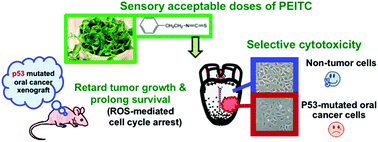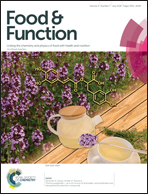Sensory acceptable equivalent doses of β-phenylethyl isothiocyanate (PEITC) induce cell cycle arrest and retard the growth of p53 mutated oral cancer in vitro and in vivo†
Abstract
High doses of β-phenylethyl isothiocyanate (PEITC), a phytochemical in cruciferous vegetables, are not feasible for consumption due to a strong mouth-tingling effect. This study investigated the anti-cancer effect of PEITC at sensory acceptable doses. In vitro, PEITC was selectively toxic to oral cancer cells (CAL-27, FaDu, SCC4, SCC 9, SCC15, SCC25 and TU138), compared to oral keratinocytes (OKF6/TERT2 and NOK/Si). In vivo, 5 and 10 mg kg−1 PEITC, equivalent to human organoleptically acceptable doses, retarded tumor growth and prolonged the survival of mice bearing p53-mutated oral cancer cells – TU138 xenograft. Mechanistically, PEITC induced ROS accumulation, nuclear translocation of p53 and p21 and G1/S cell cycle arrest in vitro; increased p53 and 8-oxo-dG levels; and decreased Ki-67 intense/mild staining ratios without TUNEL changes in vivo. These findings suggested that the sensory acceptable doses of PEITC selectively induced ROS-mediated cell cycle arrest leading to delayed tumor progression and extended survival. PEITC could be a functional ingredient for oral cancer prevention.



 Please wait while we load your content...
Please wait while we load your content...